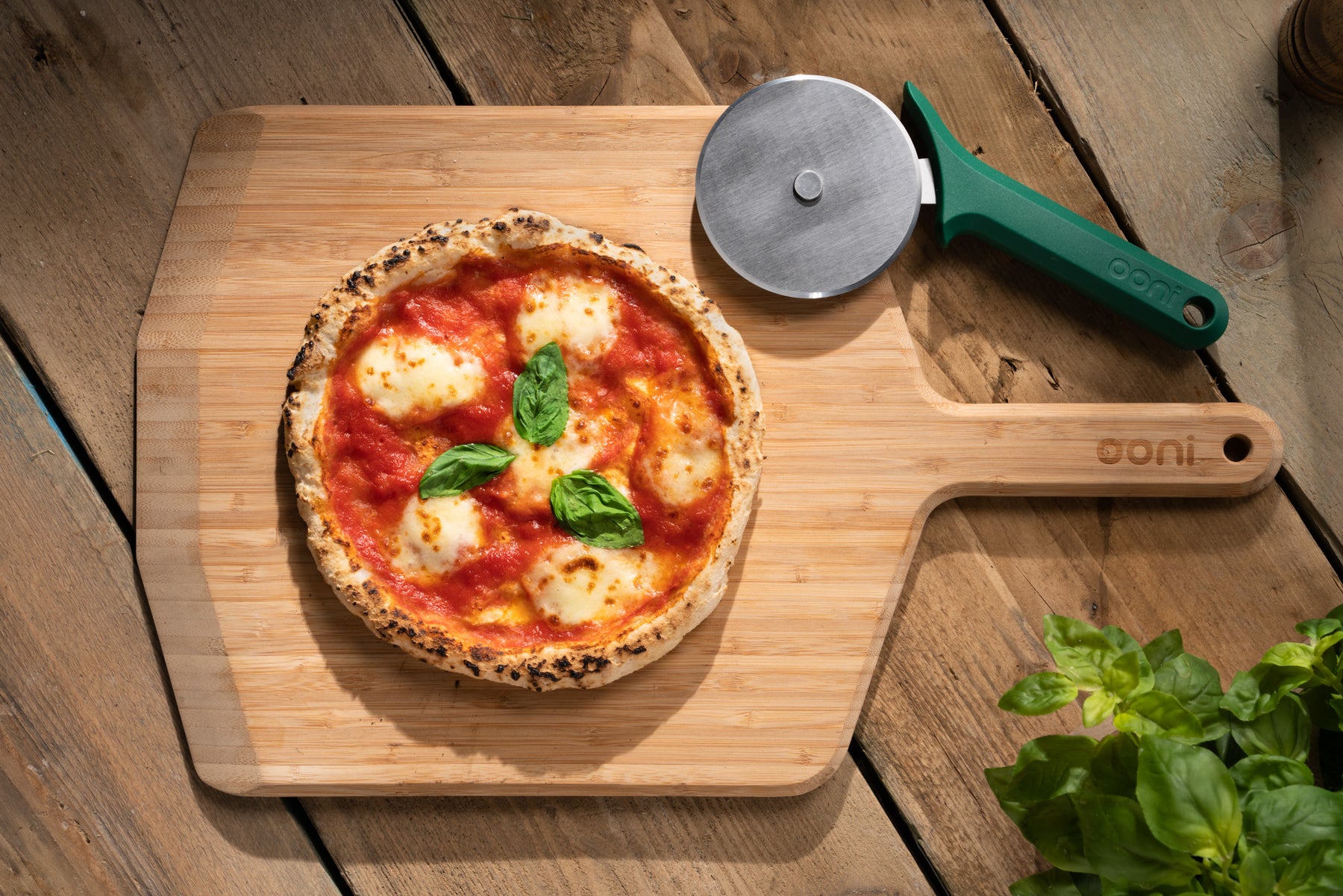Love pizza but need a pizza dough that loves you back? Your days of eating store-bought, cardboard-like crusts are over! For those with celiac disease or who are avoiding eating gluten, our awesome gluten-free pizza dough recipe uses a certified gluten-free flour brand and is super easy to make.
For this recipe, we use Caputo Fioreglut Gluten Free Flour. If you prefer to use a different gluten-free flour, It’s important to note that the results will vary significantly and may require different quantities of water, yeast and/our olive oil, plus different prove times and preparations. This recipe is our tried and tested method – it’s sure to reignite your love of pizza!
In order to avoid cross-contamination with regular flour, we recommend using separate pizza cooking accessories – pick up an extra stone baking board, additional pizza peels, and add a Green Pizza Peel Handle to your Ooni pizza peel alongside our Ooni Pizza Cutter Wheel (Green Edition) for easily identifying gluten-free cooking tools.
Ingredients
Makes 4 x 12” pizzas, equivalent to 4 x 225g dough balls
17.6oz (500g) Caputo Fioreglut Gluten Free Flour
14.1oz (400g) warm water
0.6oz (17g) salt
0.35oz (10g) instant dried yeast*
0.53oz (15g) olive oil
*Note that some dried yeasts contain gluten, so be sure to check the ingredients.
Place two-thirds of the water in a large bowl. In a saucepan or microwave, bring the other third of water to boil, then add it to the cold water in the bowl. This creates the correct temperature for activating yeast. Whisk the salt, yeast and olive oil into the warm water.
If mixing by hand:
Place the flour in a large bowl and pour the yeast mixture into it. Stir with a wooden spoon until the dough comes together in a ball. Turn onto a lightly floured surface and knead with both hands for about 10 minutes, until it is firm and well combined, and the dough ball is smooth and shiny. It’s important to note that dough that uses regular flour would be stretchy after kneading due to the gluten proteins strengthening during the kneading process. However, gluten-free flour will perform differently due to the absence of protein in the flour.
Return the dough to the bowl. Cover with plastic wrap (cling film) and leave to rise in a warm place for 1-2 hours.
If using a mixer:
Fit the mixer with the dough hook and place the flour in the mixer bowl. Turn the machine on at a low speed and gradually add the yeast mixture to the flour. Once combined, leave the dough to keep mixing to at the same speed for 5-10 minutes, or until the dough is firm and combined.
Cover the dough with plastic wrap (cling film) and leave to rise in a warm place for 1-2 hours.
When the dough has roughly doubled in size, divide it into 4 equal portions each weighing 225 grams. The dough may collapse at this stage, but don’t panic – this is normal at this point.
In a well-floured, airtight tray, leave the dough portions to rise for a minimum of one hour and up to a maximum of five hours, or until the dough balls have doubled in size.
To shape each piece of dough into a pizza base, place the first dough portion onto a well-floured pizza peel. Gluten-free pizza dough is much more delicate than conventional pizza dough, so handle the dough carefully to avoid tearing it. Press down into the dough using your fingers to flatten and spread the dough into a base, making sure not to press into the very edge of the dough so that a thicker crust can form once it cooks. You can also gently stretch the dough sideways by pressing your palms on either side of the dough and slowly pulling your hands away from each other. Take care not to tear the dough.
When the base is stretched out to a thickness of a ¼ inch (5mm), pick up the pizza peel and give it a gentle shake to ensure the base is not sticking to the peel before you start adding the toppings. Follow our 10 Tips for Launching the Perfect Pizza to avoid dough sticking to the peel.
Fire up your Ooni 3, Ooni Pro or Ooni Koda. Aim for 842˚F (450˚C) on the stone baking board inside. You can check the temperature inside your oven quickly and easily using the Ooni Infrared Thermometer.
Launch the pizza into the oven, turning it every 20-25 seconds to ensure it cooks evenly.
The gluten-free dough crust may appear to be cooked before it actually is due to the color the crust develops as it cooks, so don’t be afraid to bake the pizza a little longer. The base may also burn a little on the edges as it cooks through; simply dust those little burnt spots off after cooking.
Enjoy and share with all your gluten-free pizza-loving friends!

Glútenlaust Pizzadeig
We've seen so many questions about a fantastic gluten-free pizza dough recipe in this group - now we have one that's Oonified! Our tried-and-tested gluten-free pizza dough recipe is so easy, works fantastically well in Ooni pizza ovens, and uses Caputo's Fioreglut gluten-free flour. We'd love to hear what you all think of the recipe!
